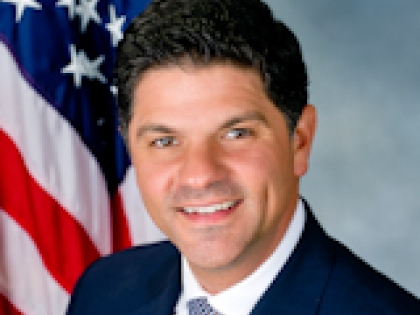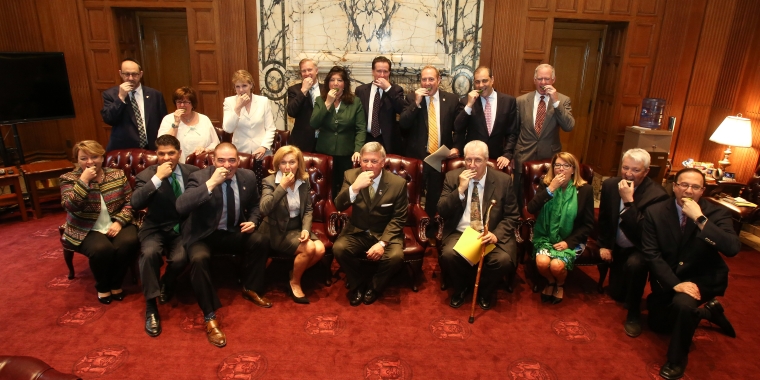
SENATOR AMEDORE ANNOUNCES PACKAGE OF LEGISLATION TO COMBAT LYME AND TICK-BORNE DISEASES
May 16, 2018

Senator George Amedore, member of the New York State Senate Task Force on Lyme and Tick-Borne Diseases, today announced the Senate has passed a package of legislation to combat lyme and tick-borne diseases. The bills increase public awareness and prevention and will improve diagnosis and treatment to better protect the health of all New Yorkers.
In addition to today’s package of comprehensive bills, the Senate also approved a resolution (J4517) designating May 2018 as Lyme Disease Awareness Month in the State of New York. The resolution raises public awareness of the causes, symptoms, and treatments of Lyme Disease and other tick-borne illnesses, and underscores important education and research efforts surrounding Lyme and tick-borne diseases.
“Everywhere I travel throughout the district, I hear from families who have been affected by lyme and tick-borne illness – it can be devastating: physically, emotionally and financially,” said Senator George Amedore. “The bills we passed today build on the historic $1 million investment in this year’s budget for lyme education, prevention and research that was championed by the Senate Task Force, and will help us tackle this epidemic that is so prevalent in our communities.”
The bills passed by the Senate today include:
Expanding Education and Public Awareness
S2588, provides homeowners with vital and reliable information on the best way to protect their property from ticks. People should be made more aware of the EPA’s approved pesticides that are recommended for tick prevention and the best methods to use pesticides to better protect both people and pets from exposure to ticks on their property. The bill directs the Department of Environmental Conservation (DEC) to develop guidelines for best practices in treating residential properties to reduce exposure to ticks.
S7242, directs the New York State Office of Parks, Recreation and Historic Preservation to install and maintain tick warning signs at all state-managed parks, including trail entryways and campgrounds. The signs will inform the public that ticks may be found in such areas and that they can spread Lyme or other diseases.
Promoting Prevention and Strengthening Treatment
S7169, establishes a pilot program for Lyme and tick-borne disease testing in children under the direction of the Commissioner of Health. This legislation will allow health care practitioners and providers to submit samples to exclude Lyme and tick-borne diseases from children who present with clinical diagnoses that have similar symptoms to these illnesses. The qualifying medical institution or laboratory chosen by the commissioner would be required to submit a report on health outcomes to DOH, as well as develop a graduate medical education curriculum to teach medical students about these illnesses.
S8534, directs the Commissioner of Education and the Commissioner of Health to promulgate and review rules and regulations related to pupils who have a tick removed from them during school or a school-sponsored activity. Both commissioners will be required to issue guidance to educators, particularly school nurses, regarding the removal of ticks from students and notification of parents. This legislation also provides for the development of informational materials on Lyme and tick-borne diseases for school districts and parents.
S8539, requires the Department of Financial Services, in consultation with the DOH Commissioner, to conduct a study considering the current scope of health insurance coverage for Lyme and tick-borne diseases. The study will also examine initiatives in other states and the fiscal implications of various proposals.
S6926, directs the Commissioner of Health to establish a standard protocol for the diagnosis and treatment of Lyme and other tick-borne diseases. This legislation requires the commissioner to work with health care providers and experts to develop a standard protocol process and patient notification of related symptoms, risk factors, diagnosis, and other information relating to Lyme and TBDs.
S7168, requires a coroner, pathologist, medical examiner or other qualified examiner that discovers Lyme and tick-borne disease infections during an examination of a deceased person to report the case to the DOH. The legislation is a result of a recent Task Force forum, in conjunction with the Senate Health Committee, to provide appropriate surveillance and statistic accounting in cases where Lyme and TBDs underlie the primary cause of death.
S7208, requires that the Council on Human Blood and Transfusion Services review current medical research and guidance regarding the donation of blood by patients with a history of Lyme or tick-borne illnesses. Concerns about blood donations and transfusions of blood with TBDs are not unfounded. In order to safeguard the state’s blood supply, its recipients, and prevent the potential spread of the disease, the council will research these concerns and make recommendations about blood donations to the Commissioner of Health based on currently available medical research.
According to reports by the Centers for Disease Control (CDC), New York State has the third highest number of confirmed cases of Lyme disease in the entire country. While this problem has historically been concentrated on Long Island and in the Hudson Valley, the state DOH reports that it’s quickly migrating to other counties across New York. Since Lyme reporting became available in 1986, there have been over 95,000 cases of Lyme in New York State alone.
The bills were sent to the Assembly.
###

